French Polynesia Trip April 13-29, 2005
Monday, June 27th, 2005 at 10:41 am by Ken
Monday, June 27th, 2005 at 10:41 am by Ken
Wednesday, March 2nd, 2005 at 3:50 pm by Ken
To: friends, family and other possibly interested persons. From February 13-21, I went back to the Bahamas for my “2nd annual” shark trip with Jim Abernethy’s Scuba Adventures. We missed out on the great hammerheads this year (fortunately, I got some decent hammie photos on last year’s trip, which are on the web site), but we were successful with bull, lemon, Caribbean reef and tiger sharks. I was watching a “West Wing” rerun recently where one of the characters said, “If you go west, be sure and stop at the Grand Canyon. It’s one of the few things in life that doesn’t disappoint when you actually experience it.” This is how I feel about Jim Abernethy’s shark trips-if you want to photograph sharks, they do NOT disappoint! So here are some photos & commentary:
|
This is the boat we take out of West Palm Beach, FL to the Bahamas. It sleeps 12 guests, but we limited the number to 8, to increase photo opportunities without stray fins, strobe arms, etc. in the photos. We still got plenty of that, but it woulda been a lot worse with 10-12 guests. We’re anchored here at a Bahamas Island called Great Isaac, which has an abandoned lighthouse. Personally, we felt it should have been named So-so Isaac, or perhaps even Not-So-Great Isaac, but what do we know? We were fortunate re: the weather-better than any of the three trips this year prior to ours, and better than the one that followed ours and is still going on right now. We were always able to find a decent anchorage to dive with some kind of shark, except the great hammerheads, which kept their distance. |
| We saw several waterspouts one am late in our trip-up to three at one time. Fortunately, they stayed some distance away and did not affect our trip. We experienced no rain for the entire seven days of diving. |
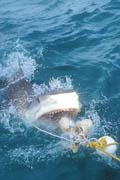 |
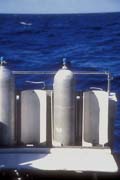 |
 |
|
Shark Bite #’s 1, 2 & 3 |
||
What I’m sure some of you were thinking was bound to happen actually did occur on this trip-I became the victim of a shark bite. The crew was doing some “shark wrangling” which consists of throwing a fish on a line into the water at the stern (back) of the boat, and then pulling it back quickly as the shark follows it in. If the shark stays around for about 15 minutes of this, we know we have a “player” and then it’s time to get in the water—wouldn’t you agree? While the wrangling is going on, it’s a good time to try for above-water photographs of the shark with its mouth open (see Shark Bite #1). What I didn’t know was that the line was secured by being tied off onto a Scuba tank, like the tank in Shark Bite #2. I was standing on the bench in the back of the boat, as modeled by Capt. Jake, a member of our crew. (see Shark Bite #3), except I was leaning forward a lot more, attempting to take photos of a large tiger shark that was going for the bait. The shark hit the line, first jerking it out of the hands of the crewperson holding it, then jerking the Scuba tank out of its hold and upward, snapping the bungee cord holding the tank in place, and pulling the tank completely into the water. Oh, and the tank snapped out and up BETWEEN MY LEGS, so that one edge of the tank bottom smashed into my shin, opening about a one-inch gash. Fortunately, kindly Dr. Howard Pelovitz (an ER Doc) was one of my fellow guests, and with his quick treatment all was soon well. Once ice & elevation of the leg had reduced the swelling, Howard put the medical equivalent of Super Glue (honest!) on the wound and covered it with a piece of plastic tape to make it watertight. I was diving the next day (this happened on Day Two of the trip) and never really suffered any ‘discomfort’ (actually, that’s called PAIN to us non-medical types). Everything has continued to heal nicely, but I’ll have a scar, which I can truthfully say is due to a shark bite. As Dr. Pelovitz kept repeating over and over (remembering the path the tank took vis-à-vis my body) “This coulda been soooo much worse!”
 |
 |
| Bull Shark #1 & #2 | |
These bull shark (Carcharhinus leucas) photographs were hard to get, as the bulls were not living up to their aggressive reputation. We had bait baskets on the sand floor and it was around dusk (shark dining time), but they were wary about approaching the divers. I kept adjusting my f stops (from f8 eventually to f2.8) until we ran out of light.
 |
 |
 |
|
Lemon Shark #1 & #2 & |
||
It’s odd, but in the shallow, sandy areas where we went for tiger sharks last year, we saw no lemon sharks (Negaprion brevirostris). When we were doing dives on reefs at 50′ or 60′, we could usually see them down below on the sand at 90′ or so. This year, we had lemon sharks on every shallow-water sand dive, up to eight at one time. Lemon shark #1 is a nice behavior photograph, as it shows 13 remoras accompanying the shark-and that’s just on its left side! Of course, when the tiger sharks showed up, you had multiple sharks to deal with-in “Bad News Comes In Threes” there are two lemon sharks on the left and a tiger shark on the right. It takes some getting used to…
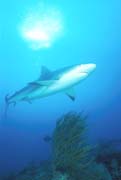 |
 |
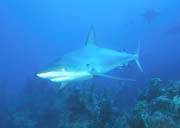 |
|
Caribbean Reef Shark #1, |
||
These caribbean reef shark (Carcharhinus perezi) photographs
were taken at a reef Jim Abernethy calls the Mother Lode, for the profusion
of reef sharks (and others) you can find there. I got a lot of photos of
these sharks last year, but two things were different this time:
(1) the reefs now had a layer of sand on them, due to the hurricanes last
fall, and the sand was easy to stir up and made photography more
challenging; and (2) I happened to go in when it was just Jim and me, and
his dutiful shaking of the bait baskets they had put down on the reef drew
the sharks in much CLOSER than last year. I mean, in-your-face close.
Caribbean reef sharks are not considered dangerous, but the scent Jim kept
stirring up got them excited and aggressive. I had my strobes bumped by
sharks three times on this one dive. Reef shark #1 is my favorite shot of
the trip-one of the few advantages we poor outmoded film shooters still have
over the digital guys is that when they shoot underwater digital photos with
the sun in the picture, the sun comes out looking strange. I’m sure
technology will correct this in time, but for now…
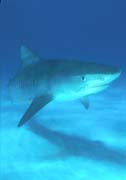 |
 |
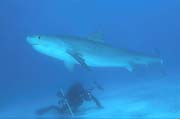 |
 |
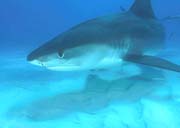 |
| Tiger Shark #’s 1-5 | |
We had some very nice tiger shark (Galeocerdo cuvier) photo opportunities, particularly with a 13 foot female Jim calls Emma
(see my prior post). We all dressed full in black (hoods, gloves, etc.) because white parts on a diver resemble bait. Unfortunately, I forgot to take off my bright yellow snorkel, which Emma seemed particularly attracted to, and thus to me. At one point, we did two consecutive 360-degree circles together (less than a yard apart), with me turning desperately to keep my housing between us. We later named this “Dances With Emma.” You’ll note in Tiger Shark #3 that my dive buddy Phil Colla is holding the “shark stick” we were required to carry on the tiger shark dives. We really felt an additional degree of security holding this thing, while trying to take pictures. Not only was it flimsy, but the white color (hello?-see dressing precautions against the color white above) did indeed attract the sharks to it-they seemed to enjoy using it as a toothpick (see Tiger Shark #4).
|
Jim And Friend |
No doubt many of you feel that I’m nuts to be doing trips like this, but I look stone sane compared to our Fearless Leader, Jim Abernethy. Here he is petting one of the tiger sharks, as it busily tries to devour the bait basket. Maybe Jim never had a dog when he was growing up… I was peering through the viewfinder to take this photograph when the shark whacked my housing with its tail fin (another shark first for me).
That’s it, folks! As always, feedback is appreciated (how did the images look? blog suggestions? questions?). For security reasons, the ability to comment back on this blog has been turned off (it helps spammers to find you). However, you can reply to the e-mail I sent you that had this URL in it, or just send me an e-mail: khoward@seaimages.org
Best to all,
Ken
http://www.seaimages.org
______________________________________________________________
Tuesday, March 1st, 2005 at 1:35 pm by Ken
Here are few photographs by Phil Colla (http://www.oceanlight.com) of me entertaining our Tiger Shark friend Emma… When I have some time I will post the complete collection of shark photos to my Stock List pages



Keywords:
Tiger Shark
Galeocerdo Cuvier
underwater photos
marine photography
Powered by WordPress
Rendered in 20 queries and 0.401 seconds.